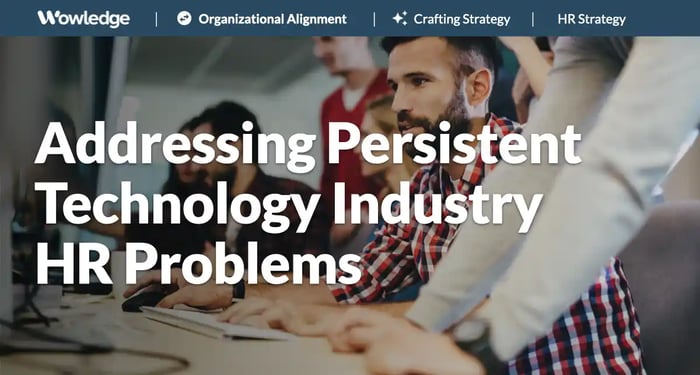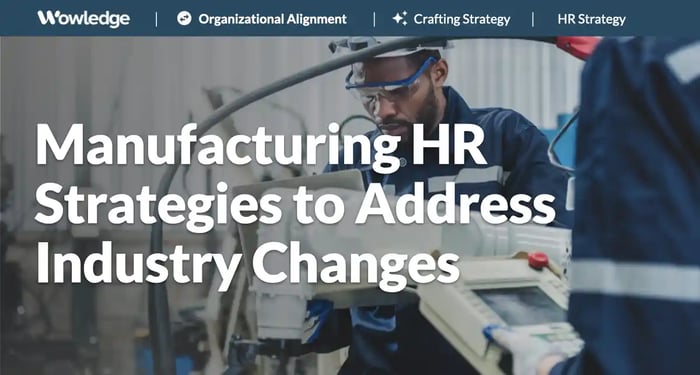Table of Contents
Of all global business sectors, the technology (“tech”) industry is perhaps the most prominent, widely covered in the media, where its trends, fortunes, innovations, and leaders are reported on, discussed, and dissected by experts and casual observers alike on a daily basis. The reason is that its presence is ubiquitous in the modern world, where its products and services influence so many aspects of personal and commercial life. It is heralded as a driver of the “digital revolution” or “information age.” With all of the innovation and advances it brings, the accompanying challenges that the technology industry HR functions face are equally immense.
The industry continues its rapid growth, despite concerns arising from layoffs and hiring slowdowns. Deloitte estimates that global IT spending will grow by 9.3% this year, led by investments in data centers and software. The rapid adoption of artificial intelligence (AI) across various business sectors is expected to drive anticipated growth at a compound annual rate of 29% over the next few years. All of that growth, however, comes with its human challenges, as technology industry HR teams grapple with talent shortages, increased competition for labor, rising salary and benefit costs, and skills obsolescence rates.
Understanding the technology industry
The tech industry is widely discussed, promoted, and given enormous coverage in the popular, business, and industry press outlets. The reason is simple: its growth, size, and reach into every aspect of our lives worldwide make it ubiquitous. Consider its reach, from interpersonal communications (phones, tablets, internet), to how we buy and acquire groceries, dinners, clothing, toys, home goods (eCommerce), enhancements to home appliances, vehicles, and how our work gets done (industrial and office automation), and as a source of entertainment and news (streaming TV and movies, digital books, online magazines and news sources).
The leading companies have caught the public’s imagination as they have emerged from garages and storefronts to now resemble the titans of the Industrial Revolution. Consider where today’s “Magnificent Seven” were 10, 20, or even 30 years ago—Microsoft, Apple, Amazon, Meta (Facebook), Alphabet (Google), Nvidia, and Tesla, and how their fortunes have expanded in full public sight. The company’s and founder’s stories have been memorialized in best-selling books, movies, and magazine cover stories, with many of those leaders attaining rock star (and multi-billionaire) status. The innovative HR policies, practices, processes, and benefits have been widely celebrated and promoted as leading-edge and best practice.
The technology industry has a profound impact on national economies, particularly in the United States. For example, the sector accounts for 8.9% of the total U.S. gross domestic product (GDP), contributing nearly $2 trillion to the American economy. It employs an estimated 9.5 million workers, whose jobs are perceived to be high-status and highly desirable based upon reports of their pay levels, benefits, perks, and public awareness of the employers themselves.
The expanding nature of the technology industry
The industry was traditionally viewed as having three primary sectors – software, semiconductors, and computer hardware and equipment. It has evolved, however, to include a broader set of companies, as electronics, software, and information computing power have been integrated into so many other industries. Investopedia defines it as companies involved in the manufacturing of electronics, creation of software, computers, or products and services relating to information technology. It includes both consumer and commercial products and services, primarily including organizations involved in:
- Software and services: Software development, cloud computing, IT consulting, and various IT services. Production and provision of business-specific products and services related to enterprise software, development and implementation consulting services, and eCommerce.
- Semiconductors and semiconductor equipment: The design, development, manufacturing, and distribution of semiconductors and related device components.
- Hardware and equipment: Production of computers, smartphones, networking equipment, and other electronic devices and components, including Smart TVs, home appliances, wearables, PCs, tablets, and peripherals.
- Internet: Those engaged in providing internet services, e-commerce, social media, and online platforms.
- Other emerging areas: These include specialized offshoots such as AI and machine learning, as well as cybersecurity. Industry-specific technologies have emerged, including those for finance (FinTech), healthcare (HealthTech), education (EdTech), agriculture (AgriTech), and others. They are increasingly considered part of the broader technology sector, reflecting its expanding influence and integration across industry groupings.
It is also essential to appreciate that every organization that relies upon and uses technologies internally—in its offices, production floors, sales and distribution channels, supply chain, and customer support operations all require software systems, hardware to communicate, house and run those, and data repositories to collect, store, and report on operational, customer, and employee insights. The internal technology expertise required to manage and run these systems is substantial and presents challenges for technology industry HR teams.

Technology industry business challenges
Competition and disruption
The tech sector is highly competitive, with established behemoths and emerging startups vying for market share and driving innovation levels as they attempt to disrupt entire industries, work processes, and production capabilities. This competition for product and service enhancements has infiltrated numerous sectors, including manufacturing, healthcare, consumer products, and the food industry. This is a long-standing challenge for those in the industry, creating high-pressure environments that focus on continuous innovation and speed to market. Interestingly, those two ends are sometimes sought at the expense of initial quality, which has spawned an entire set of methodologies focused on rapid product development cycles that generate minimally viable products (MVPs). The industry has conditioned its consumers (at least in the software sector) to expect ongoing improvements and updates that can be delivered remotely.
Data security
The prevalence of cloud computing, online financial transactions, and information access, along with widespread consumer adoption (and preferences for) mobile computing, has led to significant risks related to fraud and data piracy. Statista reports that significant institutional data compromises now exceed 3,000 per year, with data breaches, leaks, and exposures impacting the personal information of 1.35 billion individuals. The data that is being pirated and exposed is the most sensitive, primarily collected, used, and stored by financial services and healthcare organizations.
Ethical and social issues
Rapid technological advancements raise ethical and social implications that require careful consideration and responsible development. The sources, applications, and uses of artificial intelligence alone are creating considerable consternation among consumer privacy and protection advocates, as well as congressional and federal, state, and local legislators. Technology industry HR teams must support their organizations as they navigate these waters.
Technology industry HR problems
Talent demand and shortages
The demand for skilled tech professionals remains high, driven by the rapid and widespread expansion of digital transformations across industries and among employers of all sizes. As companies seek to staff the roles required to support their business goals, they face competition. The U.S. Bureau of Labor Statistics reports that computer and information technology jobs are expected to expand by 13% in the near term, despite concerns having been raised for over a decade about potential shortages. The Manpower Group found that the IT talent shortage is a significant issue for 70% of employers. IBM reports that technical skills related to AI, machine learning, process and workflow automation, cybersecurity, cloud computing, and systems architecture are in especially short supply and competitive. Companies are increasingly focused on hiring for roles such as AI, data engineering, software engineering, and product management.
Despite industry layoffs (mainly due to overhiring to meet customer demand during the pandemic) and reports of declining job opportunities for computer programmers (10% decrease), about 6,400 annual openings are projected for the next 10 years, owing to retirements and occupational changes. CIO magazine asserts that the developer hiring trend represents a lower growth rate in that job relative to other IT roles. It also highlights the pressure on developers and programmers to continually evolve by learning and mastering new languages, technologies, and tools.
Competition for talent
Related to the supply and demand challenges is the fact that so many companies across industries are competing with the technology industry for the same or similar skill sets. Not only are industry titans competing with start-ups and emerging companies in their sector, but the broad digital transformation affecting companies across the spectrum is also increasingly impacting those organizations. Surveys have revealed that companies in many industries report skill gaps and associated recruiting woes with technology-skilled workers. Of those companies, 44% report a need to fill jobs in AI, machine learning, and data science, 39% in operations and support, 30% in cybersecurity, and 29% in technology process automation.
Shrinking skill lifespans
Given the pace of technological advances, particularly with the use of AI and machine learning, technology industry HR teams must be particularly focused on the longevity of skill relevance. For example, on average, it is estimated that 39% of workers’ existing skills will be transformed or outdated in the next five years. This rapid advancement will hit technology jobs even more dramatically, with IBM reporting that “very niche technical” skills are at greater risk of expiring or becoming outdated in only 2.5 years. The skills development imperative is uniquely immediate for technology industry HR teams.
Worker demands and preferences
Technology industry HR professionals recognize that shifts in generational preferences, economic conditions, and the pandemic’s lingering effects have made attracting, hiring, and retaining skilled technology workers more challenging. What Millennial and GenZ workers want has created a seismic shift in organizations’ perspectives about balancing their preferences with the operational requirements and needs of the business. Consider the remote work preference that was unleashed during the pandemic and the return-to-work movement by many employers. That tug-of-war has revealed a highly desired flexibility in work scheduling and location that has not been seen in previous generations of workers. It highlights the search for work-life balance, a topic commonly discussed among Gen Z workers.
Given the changes in economic conditions over the past few years—including inflation, cost-of-living increases (such as for groceries and housing), and the burdens of educational, auto, and home loans—an increasing number of workers seek higher wages, which leads to tech workers conducting external job searches. 43% of STEM workers report that skills development opportunities are critical to them (enough to forgo higher pay). Furthermore, the speed of the hiring process makes a difference, as 48% of tech workers expect the hiring process to start and finish within a two-week window. Technology industry HR leaders must be prepared to create programming and support their management teams as they adapt to these emerging workforce requirements.
Employee burnout rates
The challenges for technology industry HR teams in managing worker stress and burnout are greater than in other industries due to the common cultural markers of high performance, innovation, and speed to market, combined with understaffing issues among tech workers. Boston Consulting Group, for example, found that approximately 48% of IT workers worldwide report experiencing burnout. The Wall Street Journal reported on “digital exhaustion”, a phenomenon caused by excessive use of digital devices and virtual meetings.
High-pressure environments, when combined with talent shortages, are blamed for these high rates of burnout, as IT workers feel overwhelmed by the need to handle daily responsibilities, fill in for departed colleagues, work longer hours, and continually develop their skills to keep pace with advances in the field. CIO Magazine shared those findings recently, noting that 52% of tech employees experience anxiety or depression, 50% struggle to find time to exercise or do household chores, and 36% are afraid of being judged negatively if they were to be open about those. With industry turnover rates projected to be 20-25% (vs. 14% nationally), the impact on technology company business results can be substantial.

Solving for technology industry HR pain points
With so many issues facing technology companies today, the desire to identify a “silver bullet” solution is immense and alluring. However, a systemic and integrated set of solutions should be identified and then prioritized, given the range and intensity of challenges facing any given organization. Particularly in the case of small and mid-sized (SMB) companies, which often have limited resources, HR expertise, and budgets, technology industry HR teams should take a logical, disciplined, and selective approach to problem-solving is essential.
1. Rely upon data and analysis
This represents the starting point from which to objectively identify the issues with the highest potential for impact. Use employee turnover analyses to understand the characteristics of those leaving and the reasons for leaving (RFL) by sending them anonymous surveys the day after departure. Create a robust employee listening capability (engagement, pulse surveys, targeted employee group focus groups) and use those insights to understand cultural, management, and workplace issues that drive (or mute) employee engagement and retention issues.
2. Develop and refine a talent strategy
Develop a talent strategy that plans for staffing open requirements with a range of options, using the “6B’s” approach (Buy, Build, Borrow, Bind, Bot, Bounce) to create strategies for better acquiring, developing, and managing talent. Incorporate leading-edge recruiting tactics, such as apprenticeships, partnerships with educational institutions, boot camps, and skills-based hiring and development.
3. Enhance talent marketing and branding
Develop a longer-term view of talent attraction by adopting a talent pool mentality and approach that generates interest in the company, its unique culture, and career opportunities. Treat candidate attraction as an old-time suitor would, with a slow, gradual approach to revealing the various elements and details of the employment value proposition, focusing on candidate preferences and aspirations. Use candidate relationship management (CRM) software or platforms to engage future potential candidates, communicate the company’s technological advances, work environment, culture, and career development opportunities. Work to understand what the most valued candidates look for in an employer, and be prepared to communicate how the company offers those.
4. Build change management and resilience
The nature of work in the industry is characterized by evolution, with a constant rate of change in technologies, organizational direction and focus, organizational structures, staffing levels, and shifts in the competitive market. Add to that the pressure to perform and contribute, as well as a highly competitive spirit, which calls for building a resilient and change-ready workforce. Start by hiring for competencies that support rapid change, such as resilience, adaptability, learning agility, and resourcefulness. Screen candidates using psychometrically validated tests for those soft skills, and prioritize people who have a combination of those resiliency-related attributes and capabilities, along with the necessary technical skills. Develop HR organization capabilities in strategic change management, such that when major shifts occur, planned and disciplined approaches can be used to guide managers and employees through that with less stress and friction.
5. Create great candidate (CX) and employee (EX) experiences
Making the employee experience a priority is a crucial element in establishing a compelling employee value proposition (EVP) that fosters a culture and attracts and retains top talent. Addressing their pain points by streamlining processes and simplifying the administrative and work requirements of their employment through direct engagement is key. Similarly, set expectations by doing the same for candidates, communicating a commitment to the ease of “getting things done” and foretelling what they can experience after being hired. Address the most critical elements (“moments that matter”) that drive higher engagement, productivity, and retention, such as experiential development, collaboration and network building, easily accessible learning resources, and career mobility and advancement enhancements.
6. Offer responsive benefits
This means “less foosball, more flexibility.” Focus on the benefits that matter most to the current and emerging populations of technology workers. With increasing urgency over their long-term prospects, even those educated at top universities and coming from top tech employers share issues and concerns about managing student loan debt, consumer cost escalation, achieving a work-life balance, and their psychological, physical, and financial well-being.
Leverage evidence-based HR (EBHR) and rely upon external research, benchmarking, employee listening, and human-centered design to determine benefits that will attract and retain the most business and operationally valuable employees. Provide solid welfare benefits (medical, dental, vision, life), along with lifestyle benefit support (education, planning, coaching, and reimbursements) for financial and family issues that the most significant segments of the global workforce are struggling with. Enhance opportunities and support work-life balance with creative work arrangements and scheduling, as well as stress management resources and activities.
7. Focus on managerial quality and excellence
The effectiveness of managers has a disproportionate impact on the quality of the employee experience. Gallup reports that managers continue to be responsible for 70% of employee engagement levels, and their daily interactions and impact on employees make them a critical element in hiring, developing, and retaining quality workers. With the dramatic flattening of technology organizations in recent years, middle managers have taken on direct responsibility for increasingly large numbers of employees, making their jobs more challenging than ever. A focus on selecting those with the right skills (e.g., coaching, developing, listening, and guiding) instead of those who primarily direct and discipline is a way to syndicate outstanding leadership and a constructive culture by working with the few to impact the masses.
8. Update compensation and classification structures
Prioritize the evolution of role classification and compensation plans that recognize professional growth more frequently, by providing titles and responsibilities that are meaningfully tied to capability breadth, depth, and increased responsibilities. Consider professional maturity-based grade and title progressions that provide significant growth promotion opportunities when opportunities to advance through moves into management become scarce due to flattened organization structures. Engage employees by supporting their desire for growth, increasing stature, and advanced project and deployment options that are aligned with the journey through job levels. Offer performance and contribution-based bonuses and incentives, and stock/ownership schemes to the more senior individual contributors and subject matter experts.
Relevant Practices & Tools
Advanced Change Management Practices to Enable Large-scale Organization Transformations. >
Not all change initiatives are created equal. Highly complex change initiatives require a higher-touch approach to effectively prepare the organization... more »
Developing a Winning Talent Strategy to Identify Key Capabilities and the Most Appropriate Workforce Mix. >
A talent strategy defines the talent needs and associated objectives necessary to meet top business goals. It is both an integral part of the HR strategic plan and a direct informer of the talent management strategy... more »
Accelerating the Organization Toward the Future by Building a Digital Culture. >
Companies successfully transforming their operations to a digital environment accumulate organizational momentum toward the new digital future... more »
Building Long-term Relationships with Strategic Talent Sources. >
While there are thousands of external talent sourcing channels and others that can be deployed internally, not all of the sources are productive for the organization... more »
The Focus Group Summary Tool: Capture and Aggregate the Output of Multiple Focus Groups' Data into a Single Document. >
The Focus Group Summary Tool is designed as a data collection and summarization template to support decisions regarding which metrics and analyses to provide to functional managers and leaders on an ongoing basis... more »
About Wowledge
Wowledge is the implementation-first platform designed for lean HR teams and consultants who need to design and scale strategic HR programs efficiently—without starting from scratch.
Our members gain access to continuously updated best practices, step-by-step guidance, expert-built tools, and customizable templates—all structured to accelerate the development and implementation of key HR programs.
Recognizing that every organization operates at different levels of sophistication, Wowledge’s scalable system of best practices follows a stage-based approach—Core, Advanced, and Emerging—ensuring HR professionals can implement solutions tailored to their organization’s unique needs and goals.
Your Shortcut to Amplifying HR Impact!
Get started for FREE! Learn more.










